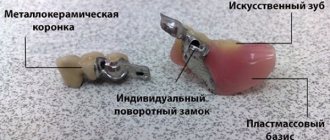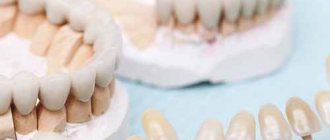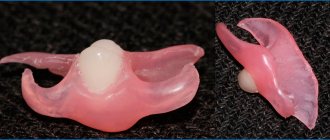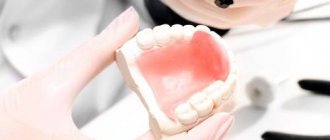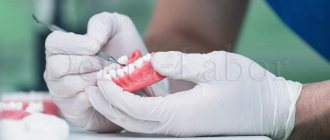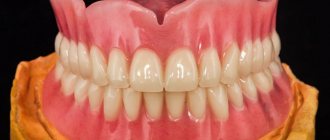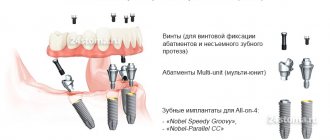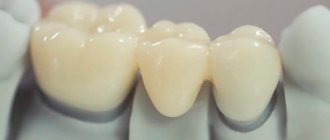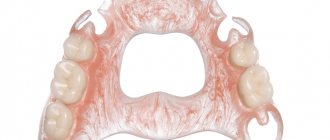The design of the clasp prosthesis consists of the following main components:
- Metal frame-arc
- Support-retaining elements
- Artificial teeth attached to an arch
The metal arch, which runs along the palate of the upper jaw or under the tongue, is an important component of the clasp denture, as it combines two bases on which artificial teeth are installed.
Base - an element of the prosthesis, including artificial teeth and connected to the branches of the metal parts of the supporting prosthesis. With the help of locks (connecting elements), the base is installed and secured to the supporting teeth, while resting against the alveolar process.
The base is made of plastic reinforced with metal mesh.
Prosthetics using clasp
Modern dentistry allows you to use this type of removable prosthetics, such as a clasp denture, when several teeth are lost.
Most experts believe that there is no alternative to it today: the advantage lies in the comfort of wearing and the even distribution of the load when chewing between the remaining teeth and gums.
Prosthetics using a clasp makes it possible to replace any part of the teeth.
Advantages
They are distinguished by the presence of a cast metal frame in the form of a thin arc - a clasp. The plastic base and artificial teeth are fixed on this thin frame.
Dentures are installed in cases where it is impossible to use permanent structures in the form of a bridge. The thin arch in clasp dentures makes wearing them comfortable - it does not cover the palate, making it possible to feel the taste of food.
Clasp denture on the lower jaw
If a prosthesis is installed on the lower jaw, the metal arch does not allow it to fall out and does not interfere with the movement of the tongue. In addition, diction does not deteriorate during a conversation. Thanks to the clasps, the service life of dentures increases to 5 years; for plastic options, this period is 2.5 years.
It has been established that bone tissue and gum tissue atrophy over time when wearing prostheses, their shape changes and no longer coincides with the shape of the prosthesis. Discomfort, pain appears, and fixation worsens. Under clasp dentures, such atrophy occurs much more slowly - this allows you to increase the period of wearing them.
Features of clasp dentures
The first clasp dentures had the shape of an arc. Even the name of this design is literally translated as “arc”. The main advantage is that the clasp denture distributes the chewing load across all supporting teeth and hard tissues of the oral cavity. But unlike removable dentures, they do not completely cover the palate or most of the gums. This means that they do not distort the sense of taste, do not affect diction, and getting used to them takes less time.
In the form of fastening on clasp dentures, a beam, locks and clasps are used. All of them do not injure tooth tissue and do not interfere with chewing or talking. In addition, their special installation ensures an aesthetically pleasing appearance while smiling.
Clasp prosthesis is partially removable. Patients can take it off in one motion and put it on just as easily. But it is worth noting that there is no particular need to remove the clasp dentures at night, as happens with removable plastic dentures. In most cases, patients remove it only to perform hygiene procedures. Due to the special type of fastening, the clasp denture will never fall off during chewing or talking, which is considered its main advantage over other dentures.
Advantages and disadvantages
Experts highlight the following advantages of clasp-type dentures:
- uniform distribution of chewing load throughout the entire jaw;
- aesthetics, which is achieved by equipping the structure with tiny fasteners;
- comfortable wearing, which is ensured by the small size of the metal frame;
- strength and reliability (the metal arc can withstand regular and heavy loads, unlike polymer analogues).
The disadvantages of clasp structures may not appear if the preparatory work for installing the prosthesis and measurements are performed at a high level. Most of the complaints from patients are related to calculation errors by the dentist.
As for the prosthesis itself, despite its strength, sometimes there are cases of clasps breaking. Such a defect cannot be repaired; the entire structure must be replaced.
The disadvantages are also attributed to the high cost of the product, but it is quite justified. The metal arc casting process involves the use of high-tech technology that requires high precision.
This ensures the strength and reliability of the prosthesis, hence the long service life, which is fully compensated by comfortable wearing.
The structure of the clasp prosthesis
The main parts of a clasp denture are a metal frame, the fasteners listed above, an arch, and also a base on which artificial teeth are attached. The arch, clasps and base are responsible for fixation in the prosthesis. Support-retaining structures in clasp dentures are solid, individually cast from metal and then soldered, and also soldered wire. The choice is made purely individually depending on the number of missing teeth and the condition of the jaw.
In most cases, clasps are used. They are special hooks that hold the clasp denture on the supporting teeth:
There are several ways to make a clasp for clasp dentures:
- It is considered simple to bend the wire in accordance with the shape of the prosthesis model.
- A complex clasp is cast as a solid crown from a special alloy during the manufacture of the arch of the clasp prosthesis.
But the holding elements are divided not only according to the manufacturing method.
There are clasps:
- supporting;
- holding;
- performing these two functions at once.
The first distribute the load from the clasp denture, which occurs during talking, chewing, clenching teeth, onto the supporting teeth and partially onto the mucous membrane. In contrast, the retaining clasps of clasp dentures transfer the load to the mucous membrane, plunging into it when pressure occurs. The latter are capable of performing the functions of both the former and the latter.
All clasps consist of several parts. The clasp body of the clasp denture is located on the supporting tooth in its upper area. The clasp arm touches the side surface of the tooth. Due to the presence of an occlusal pad, the clasp prosthesis does not sink deep into the gum and does not injure it during chewing. In addition, it is able to restore the height of crowns. In addition, there is a process of the clasp or that part of it that is located in the body of the base of the clasp prosthesis.
Clasp dentures with locking fastening look and attach differently. Unlike dentures with clasps, they are completely invisible to others, because fixation is carried out by micro-locks that are located in the clasp denture system.
In this case, metal-ceramic crowns are placed on the supporting teeth, in which one part of the lock is attached. Its second part is fixed in the clasp prosthesis. During dressing, the clasps are fastened and the denture is securely held in the oral cavity and does not fall off during chewing. In this case, the load from the clasp denture falls only on the supporting teeth, so you should not use this method of fixation in cases where the teeth have mobility.
Based on the fastening methods, it remains to conclude that a clasp denture is indicated only in cases where there are supporting teeth. Without them, the clasp prosthesis will not hold.
In addition to the support system, the clasp prosthesis has a base. The teeth are attached to it. Today, prosthetics are carried out using various dental manufacturing companies. Due to this, you can achieve high aesthetics and an attractive appearance. The same applies to the plastic used for the base of the clasp prosthesis. High-quality materials have a long service life and are distinguished by their perfect resemblance to living gums and natural teeth. The price of such a prosthesis will be a little more expensive, but it will have virtually no disadvantages.
You can choose a suitable clasp prosthesis from the photo, but it is better to hold it in your hands. Therefore, only a visit to the dentist will provide comprehensive information about the clasp denture.
Indications and contraindications for use
Clasp dentures are used for treatment in the following clinical situations:
- Dental defect in the anterior or lateral part of the jaw;
- Loss of several teeth in a row;
- Lack of teeth, which is combined with periodontal diseases, abrasion of dental tissues;
- Mobility;
- Unilateral or bilateral root defects.
Prostheses are not installed in the following cases:
- Absence of all teeth;
- Presence of less than 5 supporting teeth;
- Low height of clinical crowns;
- Poor hygienic care of the oral cavity;
- Severe periodontal tissue diseases;
- Acute inflammatory processes in the oral cavity;
- Dental diseases;
- Deep bite;
- Diseases of the temporomandibular joint;
- Allergy to materials used;
- Serious pathologies of the body;
- Period of exacerbation of diseases.
Clasp dentures have a number of advantages over bridges:
- Installation of clasp removable dentures does not require preparation of some teeth and does not limit their mobility.
- Chewing pressure is evenly distributed between the alveolar processes and the remaining teeth.
- Clasp dentures are hygienic; they can be cleaned mechanically outside the oral cavity.
To individually assess the condition of your teeth and make various solutions to your problem, you need to have a free consultation with an orthopedic dentist. A highly qualified specialist will help in any of your situations.
Conclusion: Indications for the use of removable clasp dentures
In persons with partial absence of teeth, along with end defects, combined and included defects are often encountered. Plate and clasp removable dentures can successfully replace end defects. Clasp dentures have a number of significant advantages over removable plate dentures:
- The base part of clasp dentures is minimal.
- The arch in the prosthesis ensures uniform distribution of the load between its sides.
- The prosthesis contains supporting clasps, which allow partial transfer of the load through the tissues of the supporting teeth.
- Compared to other complete removable dentures, clasp dentures can be slightly adjusted.
- The oral mucosa and gingival papillae are partially released.
- Reliable fixation of the prosthesis speeds up adaptation.
Varieties
With rectangular profile
The rectangular beam, which became widespread, was first invented by K. Rumpel. Its peculiarity is that the main pressure is transferred to the beam and only a small part falls on the mucous membrane of the alveolar process. There is a gap of 1–2 mm between the bar and the gum to perform hygienic procedures.
With an ovoid profile
The beam structure, developed by E. Dolder, has an ovoid profile with a height of 3 mm and a width of 2 mm. A metal strip 0.2 mm thick acts as a bushing. The gap between the middle of the bushing and the highest point of the beam is 1 mm. As chewing load increases, the sleeve moves, thereby improving the functionality and performance of the system.
With T-profile
Research conducted by Selchukov S.G. allowed us to come to the conclusion that the T-shaped profile has the least deflection compared to other structures. The beam made of cobalt-chrome-nickel alloy is attached to push-button cylindrical locks and is equipped with platforms along the entire length. The matrix is made of polypropylene. In order to improve the shock-absorbing and fixing properties of the system, a gap of 1 mm is left between the upper part of the beam and the matrix. Push-button locks provide reliable adhesion to the supporting teeth, which generally has a positive effect on the strength of the structure.
With cast blanks
The first use of cast blanks for a beam-type prosthesis was proposed by RT Williamson in 1991. Their installation required preliminary processing of the remaining teeth. Its goal was to obtain smooth surfaces without sharp corners and an occlusal gap for fixation of artificial units.
Then plastic pins are inserted into the previously prepared root canals for the subsequent production of their metal counterparts. The cavities into which the pins will be installed are covered with cotton balls and a bandage, which eliminates the risk of infection. Based on the impressions obtained, metal pins are cast, which, after polishing, are fixed to the patient. If necessary, correction is carried out, and then a prosthesis is made by a specialist in a dental laboratory. After polymerization of the plastic base, the prosthesis is ground and polished. Replacement clamps are then installed. This technique significantly reduces the cost of prosthetics, and also improves the fixation of the structure and the condition of the periodontium by shortening the crown.
Caring for a clasp denture
As already mentioned, the clasp prosthesis does not need to be removed at night. You can wash it in the morning after sleeping and in the evening after eating using a toothbrush. There are many products for caring for dentures, including rinses. The doctor can explain to you how they work and help you choose based on the materials of the clasp prosthesis.
Clasp dentures are not suitable for everyone. The condition of the teeth is important, as well as the general reaction to the materials from which the prosthesis is made. However, here too experts have found a way out, using a special type of plastic that does not cause allergies. The cost of such a clasp prosthesis will be a couple of thousand rubles more than a simple one, but you will be able to use it with great pleasure.
No patient can choose a denture option on their own. Only the dentist will determine the condition of the jaw and supporting teeth, and also select the type of clasp denture.
All you have to do is make an appointment with a dentist at our center and receive all the comprehensive information from him. Once you understand what a clasp prosthesis is, we are confident that you will give us a positive review, like many others.
